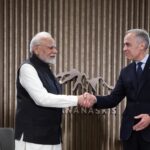India and Canada signaled a decisive reset in their economic engagement, with Commerce and Industry Minister Piyush Goyal on November 24, 2025, calling for rapid progress on stalled free trade negotiations and urging both countries to leverage emerging synergies in critical minerals, clean energy and frontier technologies.
Speaking at the Indo-Canadian Business Chamber in New Delhi, Goyal framed the economic relationship as one grounded in complementary strengths and mutual advantage, arguing that India’s expanding technological capabilities and Canada’s resource depth create “considerable scope” for long-term collaboration at a time when global supply chains are being rewritten.
Goyal’s remarks carried added significance given the geopolitical thaw of the past year. The minister referenced the recent meeting between Prime Minister Narendra Modi and newly elected Canadian Prime Minister Mark Carney during the G20 Summit — a conversation that produced the first political green light in more than two years to resume negotiations on a “high-ambition” Comprehensive Economic Partnership Agreement, or CEPA.
Both leaders have committed to nearly doubling bilateral trade to USD 50 billion by 2030, a goal that implicitly acknowledges that the current USD 30.9 billion exchange of goods and services remains far below potential for two G20 economies with deep people-to-people ties.
Much of the renewed optimism rests on structural shifts. Goyal said India’s national grid — with 500 GW of installed capacity, half of it green — now provides the backbone for AI-led and energy-intensive infrastructure, giving the country the ability to offer 24-hour clean power at globally competitive rates. With India targeting 500 GW of clean energy alone by 2030, New Delhi is positioning itself as a dependable partner for countries seeking stable, low-carbon supply chains.
This aligns closely with Canadian priorities, particularly in uranium supply for India’s nuclear program and cooperation in advanced clean energy technologies. Goyal also argued that Canada’s strengths in mineral resources, including critical minerals essential for batteries, semiconductors and renewable technologies, fit cleanly with India’s ambitions to expand domestic manufacturing under its Make in India agenda.
The minister underlined that India’s capability in areas such as artificial intelligence, quantum computing, machine learning and large-scale data centers gives it an innovation edge supported by the world’s largest annual pool of STEM graduates. As countries diversify away from concentrated technology ecosystems, Goyal said, a Canada–India partnership could become vital to building secure, democratic and resilient digital frameworks. He pointed to the government’s recently announced USD 12-billion research fund as a platform for co-innovation and invited Canadian companies to participate in India’s AI Summit later this year.
The shift in tone is also tied to political developments in Ottawa. Trade talks had collapsed in late 2023 after allegations by the Trudeau government over the killing of a Khalistani separatist figure sharply derailed diplomatic engagement. New Delhi had dismissed the claims as “absurd”, and the freeze persisted until Mark Carney’s election in March 2025. A subsequent meeting between Modi and Carney at the June G7 Summit in Italy opened the door for re-engagement, followed by ministerial conversations in November that paved the way for Monday’s renewed push.
Goyal said business confidence has remained resilient even through periods of political turbulence, with Canadian pension funds alone having invested an estimated CAD 75 billion in India and more than 600 Canadian companies maintaining a physical presence in the country. He characterized the India–Canada relationship as “strong and stable”, rooted in democratic values but now driven increasingly by economic pragmatism and the need to secure future-facing supply chains.
On India’s macro fundamentals, Goyal reiterated that the country has moved decisively beyond its “Fragile Five” label and is now positioned among the world’s top five economies, with a credible path to becoming the third-largest in the next two to two-and-a-half years. He cited low inflation, a healthy banking system, high foreign exchange reserves, accelerating infrastructure expansion and buoyant equity markets — which he said have grown more than four-and-a-half times over 11 years — as indicators of sustained momentum. India’s development model, he said, rests on macroeconomic stability combined with inclusive growth and a welfare architecture enabling broad-based participation in the economy.
Looking ahead, Goyal proposed a five-pronged strategy to convert political intent into measurable outcomes, calling for sector-specific roadmaps, revitalization of the CEO Forum, deeper business-to-business links and focused collaboration in critical minerals, clean energy, aerospace, defense and next-generation manufacturing. He argued that Canadian innovation paired with India’s scale and cost-effective R&D capacity can unlock opportunities far larger than either market individually offers.
Inviting Canadian firms to partner in India’s ambition to become a developed economy by 2047, Goyal said New Delhi offers a stable, transparent and opportunity-rich environment for long-term investment. The message was clear: after years of drift and diplomatic chill, India wants a trade relationship with Canada that is strategic, technology-driven and anchored in mutual economic benefit — and it wants it to move quickly.






